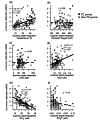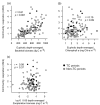Effects of Tropical Cyclone Passage on Plankton Community Respiration in a Phosphate-Limited Freshwater Ecosystem
- PMID: 38628164
- PMCID: PMC11019429
- DOI: 10.6620/ZS.2023.62-58
Effects of Tropical Cyclone Passage on Plankton Community Respiration in a Phosphate-Limited Freshwater Ecosystem
Abstract
Plankton community respiration (CR) in aquatic ecosystems varies with environmental factors, which could be altered during tropical cyclones (TCs). A potential increase in CR resulting from the effects of TCs is generally understudied. Here, we examined the relationship between plankton CR and environmental factors, including during TC-affected periods, in a phosphate-limited freshwater ecosystem. We conducted an intensive in situ sampling in Fei-Tsui Reservoir (FTR) from January 2010 to December 2015 during TC periods and non-TC periods. Our results showed a consistent temporal pattern that plankton CR increased between March to October and declined between November to February. These changes in plankton CR, primarily supported by bacterial biomass, were positively influenced by euphotic depth-averaged temperature. The CR also significantly increased with euphotic depth-averaged NO2-concentrations and decreased with euphotic depth-averaged NO3-concentrations. These results indicated that these factors typically influenced CR dynamics in the FTR. During TC periods, plankton CR was increased further due to a higher and ideal euphotic depth-averaged temperature (23-27°C) and increased supply of limiting nutrient resources via stream runoff. Overall, this study showed that a TC positively influences plankton CR by creating favorable water conditions. Notably, with a higher frequency of intense TCs projected for the Western North Pacific in most climate change scenarios, the impact of TCs on CR may increase in the near future.
Keywords: Bacterial biomass; Oligotrophic lake; Plankton; Total community respiration; Typhoon.
Figures






References
-
- Andersen T, Hessen D. 1991. Carbon, nitrogen, and phosphorus content of freshwater zooplankton. Limnol Oceanogr 36(4):807–814. doi:10.4319/lo.1991.36.4.0807.
-
- Bottrell H. 1976. A review of some problems in zooplankton production studies. North-West J Zool 24:419–456.
-
- Chang CW, Shiah FK, Wu JT, Miki T, Hsieh Ch. 2014. The role of food availability and phytoplankton community dynamics in the seasonal succession of zooplankton community in a subtropical reservoir. Limnologica 46:131–138. doi:10.1016/j.limno.2014.01.002.
LinkOut - more resources
Full Text Sources
